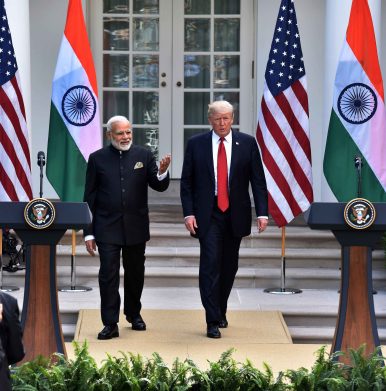By Pratik Chougule
Ahead of U.S. trade representatives arriving in New Delhi on Friday, President Donald Trump fired off another Twitter attack on July 9: “India has long had a field day putting Tariffs on America products. No longer acceptable!”
The tweet follows Trump’s meeting with Prime Minister Narendra Modi at the G-20 Summit late last month, where the leaders agreed only to further meetings to resolve an ever-growing number of trade disputes, from import quotas on agricultural goods to price caps on medical devices to outsourcing and intellectual property protections on generic drugs.
Prior to the summit, Trump had delivered a similarly threatening tweet: “India, for years having put very high Tariffs against the United States, just recently increased the Tariffs even further. This is unacceptable and the Tariffs must be withdrawn!”
Trump was alluding to the ongoing conflict regarding India’s membership in the General System of Preferences (GSP). The trade benefits India enjoyed under the international development program had grown more contentious for Trump at home as the FDA and state attorneys general launched investigations into Indian pharmaceutical manufacturers for price fixing and data integrity issues — investigations that their American competitors in key swing states have welcomed. Just a day after Modi’s re-election in May, the Trump administration ended India’s preferential treatment under the GSP. India retaliated with tariffs on 28 American products worth more than $200 million.
Within days of the G-20 meeting, the two countries were embroiled in World Trade Organization disputes. India filed a complaint regarding the Commerce Department’s impending countervailing duties against India’s alleged currency devaluation. The United States filed a consultation request challenging Indian tariffs.
Unlike other countries embroiled in trade wars with the Trump administration, from China to Mexico to Japan, Trump has evinced little animosity toward India generally or Modi specifically.
Rather, trade tensions with India stem from a gap between American public opinion and a calculus that has steered U.S. policy for more than a decade. Recognizing that U.S.-India trade involves powerful domestic constituencies in both countries, the Bush and Obama administrations largely bracketed the issue to facilitate a partnership in other areas such as defense and civil nuclear cooperation. Progress on these fronts, they calculated, would build the confidence and political capital necessary to ameliorate more divisive trade dilemmas.
Instead, U.S.-India trade disputes not only persisted, they became implicated in the most sensitive U.S. domestic issues from health care to immigration, which boiled over in an “America First” backlash and a populist makeover of the Republican Party.
The Trump administration’s statement in June terminating “India’s designation as a beneficiary developing country” was not simply an assessment of India’s improving growth dynamics. It undercut an important rationale for the United States’ historically forgiving stance toward India: that strict trade regimes can complicate efforts to tackle challenges associated with poverty and disease. In the name of broad-based accessibility, Washington has historically resisted sanctioning Indian companies in areas like generic drugs for inconsistent standards on quality controls and patent challenges that invalidate the intellectual property of American competitors. Implicit in the Trump administration’s policy is a signal that Washington will no longer jeopardize American companies’ ability to invest in research and development for the sake of a rising competitor’s development agenda.
The controversies at the forefront of U.S.-India tensions — from visa fees for high-tech workers to import bans — pit elite perceptions of U.S. interests against populist assumptions that Indian trade practices come at the expense of American jobs. They expose gulfs between the prerogatives of the foreign policy establishment and a public less supportive of globalization and more enthusiastic about protecting American jobs as foreign policy goal. While economists at elite universities are in near unanimous agreement that steel and aluminum tariffs are harming Americans’ welfare — in part due to the disruption of trade with India — the American people appear more ambivalent.
These divides are exacerbated by 2020 politics as Trump gears up a “base only” re-election campaign. Trump’s Republican supporters are outliers in their skepticism toward U.S. initiatives on international trade, immigration, and global development — a worldview translating into wariness toward India. More so than his predecessors, who actively courted the increasingly influential Indian-American community, Trump faces zero-sum choices between his base and a diaspora seeking to bolster U.S.-India ties. In 2016, Trump prevailed with just 16 percent of the Indian-American vote and losses in four of the five states with the largest Indian-American population. In this context, Republicans are less inclined to accept the outsourcing of generic drug manufacturing or Indian tariffs on iconic American goods like Harley Davidson motorcycles as inevitable costs of the bilateral relationship.
Avoiding a trade war will require Washington and New Delhi to address the populist pressures weighing on Trump’s 2020 bid.
Pratik Chougule is the former policy coordinator on the Trump 2016 presidential campaign. From 2008-2009, he served at the State Department in the Office of the Under Secretary for Arms Control and International Security, where he worked on the 2008 U.S.-India nuclear accord.

No comments:
Post a Comment